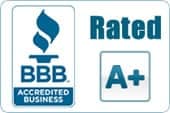When most people hear the term “storm drain”, they usually associate it with the large grates in the middle of parking lots, or even the drains in the curbs in the street. While these are definitely storm drains, they are not the only part of a storm system.
Knowing this, and the unique challenges that surround them can really help in several ways. The first step is to understand exactly what they are.
What is a Storm Drain?
While many people think that storm drains are part of the sanitary sewer system, it is important to know that they are not. When sewage is collected, it is treated at a waste water treatment facility. This treatment renders it safe to be introduced back into the environment, or to be used for purposes such as irrigation, or other non-potable water uses.
Water from storm sewers is not treated like sewage is, and is reintroduced into the environment directly. This means that it is important to not mix the two. It is actually illegal to allow groundwater to enter a sewer system, and vice versa.
So, a storm drain is any drain that allows for the collection and transportation of ground water to a point where it can be rereleased into the environment. A storm system can include your roof gutters and downspouts, drains in your landscaping that carry ground water away from one area to another, or any number of other applications.
What Are the Unique Challenges?
One of the most obvious challenges is the fact that, while they are not designed to carry “waste”, they do have a tendency to collect debris. Dirt, leaves, a random golf ball, etc… all of these things can clog up a storm drain pretty quickly.
Due to the fact that corrugated piping is often used in smaller, residential applications, means that not only are they more likely to clog, but when they do, they are much more difficult to unclog. Regular sewer cleaning equipment very often cannot be used for these smaller pipes.
If the pipe is big enough, and made up of strong enough material to allow the use of tradition drain cleaning equipment, it is usually too big for the machines to do the job properly. For this reason, a hydro jetter is usually the equipment of choice in these situations.
Another thing to consider is that if you do not check your storm drains prior to periods of heavy rainfall, you will not know that you have a problem until the system backs up. Everything becomes much more difficult when flooding is a factor.
What Can You Do?
Here are some things that you can do to help keep your storm system running properly, as well as do your part to help the environment.
- Be very careful of what you allow down the storm system. Avoid washing your car in your driveway, do not dispose of oil-based liquids, or anything else into the storm system that does not naturally belong there.
- Make sure that your storm grates are secure, and allow the water to flow through them, but nothing else. This will help keep debris from clogging your lines.
- Check your entire storm system, prior to periods of heavy rain. Clean those roof gutters, and run some water down all of your storm drains to make sure they drain properly. Preventive maintenance is the key.
- Call a professional if you have a problem with your storm drains, or any part of your storm system. Remember, Allstar Plumbing is here to help.
Give Allstar Plumbing a call today!




